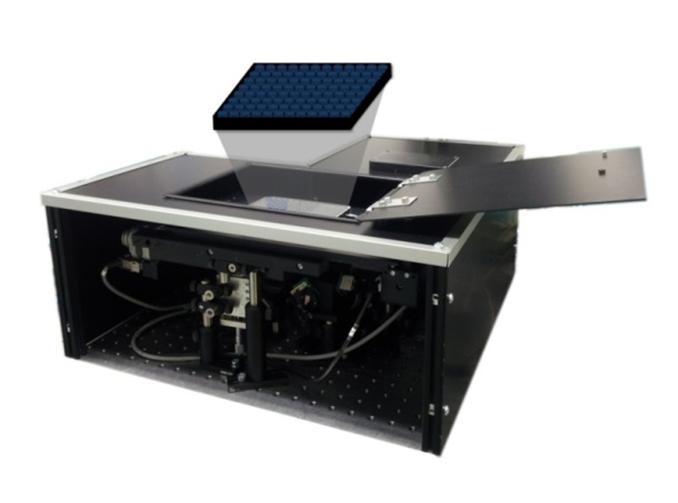New process for cell transfection in high-throughput screening

Functional model for high-throughput screening. Illustration: LZH
This transfection method is characterized by molecules entering the cells through an optically induced process. By attaching the gold nanoparticles to the cells, a photothermal effect is achieved under laser irradiation, which enables an efficient transfer of molecules into the cells.
Many advantages by changing the method
In comparison to the established methods for cell transfection, the risks and efforts can be considerably reduced by the gold nanoparticle process. The use of an optical mechanism also makes the method much more independent from the cell type and molecules used. Also, within larger samples, the transfection can be carried out both more precisely and cell-specifically.
Application tests and method comparisons for customers
Within the course of the project, a large amount of application data could already be collected, and application fields could be verified. The Biophotonic Imaging & Manipulation Group offers testing services for customer-specific methods and questions. Also, methods for cell transfection processes can be compared according to customer requirements.
Follow-up project with new partners
The project has been successfully completed by presenting a functional model. Now, the scientists are planning to continue their work. Methods for use in high-throughput testing shall be further developed and made ready for the market. Presently, the LZH is looking for partners from the screening area to build a prototype in the follow-up project.
The project “Setup and testing of a functional model for gold nanoparticle-based (GNOME) laser transfection in high throughput mode” is IGF project no. 18129 N of the Forschungsvereinigung Feinmechanik, Optik und Medizintechnik F.O.M. (Reseach Consortium Fine Mechanics, Optics and Medical Technology). It is supported via the German Federation of Industrial Research Associations “Otto von Guericke” e.V. (AiF) within the framewok of the Industrial Joint Research (IFG) of the Federal Ministry for Economic Affairs and Energy (BMWi). The members of the advisory committee were: Center for Applied Nanotechnology (CAN) GmbH, Cenix BioScience GmbH, European ScreeningPort GmbH, IBA GmbH, LaVision BioTec GmbH and LLS Rowiak LaserLabSolutions GmbH.
Media Contact
All latest news from the category: Process Engineering
This special field revolves around processes for modifying material properties (milling, cooling), composition (filtration, distillation) and type (oxidation, hydration).
Valuable information is available on a broad range of technologies including material separation, laser processes, measuring techniques and robot engineering in addition to testing methods and coating and materials analysis processes.
Newest articles

Superradiant atoms could push the boundaries of how precisely time can be measured
Superradiant atoms can help us measure time more precisely than ever. In a new study, researchers from the University of Copenhagen present a new method for measuring the time interval,…

Ion thermoelectric conversion devices for near room temperature
The electrode sheet of the thermoelectric device consists of ionic hydrogel, which is sandwiched between the electrodes to form, and the Prussian blue on the electrode undergoes a redox reaction…

Zap Energy achieves 37-million-degree temperatures in a compact device
New publication reports record electron temperatures for a small-scale, sheared-flow-stabilized Z-pinch fusion device. In the nine decades since humans first produced fusion reactions, only a few fusion technologies have demonstrated…





















